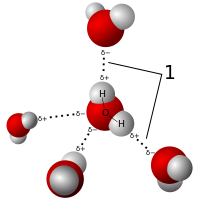
Photo from wikipedia
The influence on the geometric characteristics and acceptor properties of the amino groups has been studied in substituted diaminobenzenes. Quantum-chemical calculations using different approaches to the modeling of a polarizing… Click to show full abstract
The influence on the geometric characteristics and acceptor properties of the amino groups has been studied in substituted diaminobenzenes. Quantum-chemical calculations using different approaches to the modeling of a polarizing environment have shown the most significant influence of the nitro group in the ortho and para positions relative to the amino substituent. The study of the crystal packing of mono- and dinitrodiaminobenzenes has revealed the increasing role of stacking interactions in the crystal structure up to the formation of the building unit. In most cases, stacking interactions compete with the N–H⋯O hydrogen bonds, forming the primary basic structural motifs (BSM) or bonding them. The N–H⋯N hydrogen bonds with the nitrogen lone pair as proton acceptor have been revealed for the meta-amino groups and play a negligible role in crystal packing, bonding the secondary BSM. Surprisingly, the N–H⋯N hydrogen bonds in the crystals of 3-amino-4-nitroaniline form the primary BSM, but they may be considered rather the N–H⋯π interactions.
Journal Title: CrystEngComm
Year Published: 2017
Link to full text (if available)
Share on Social Media: Sign Up to like & get
recommendations!